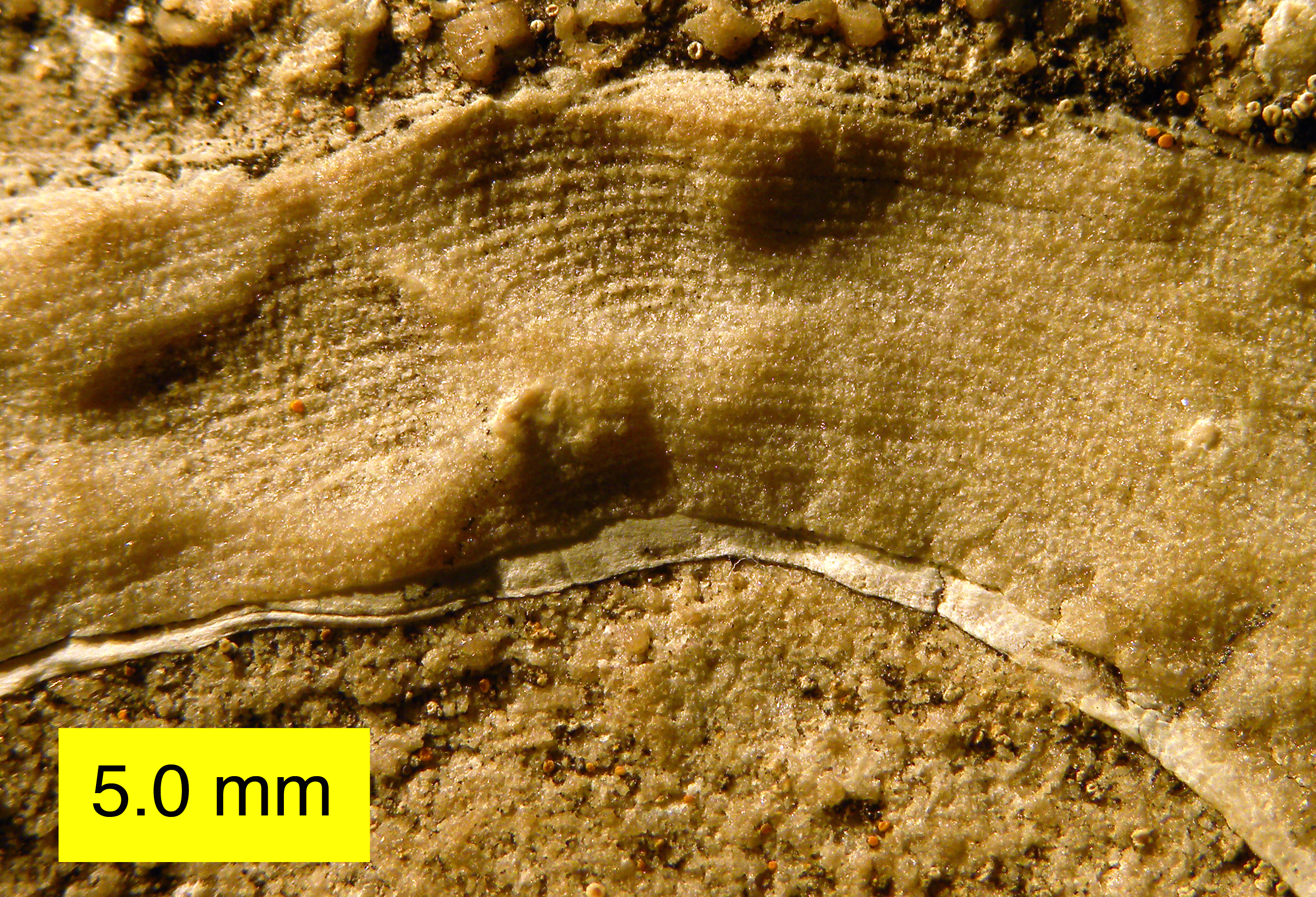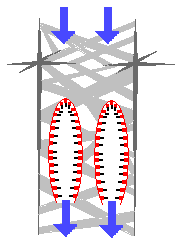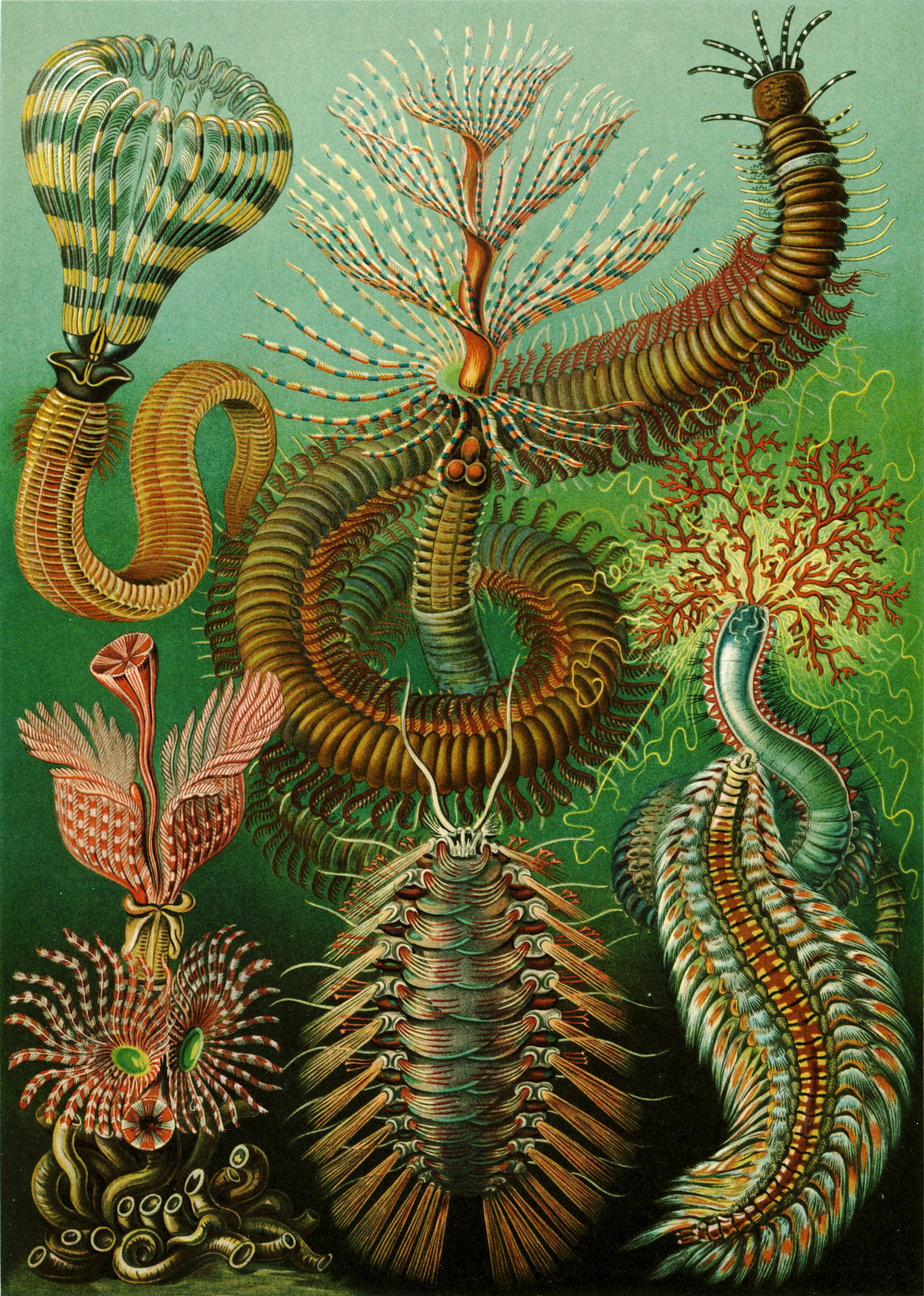|
Sponges
Sponges or sea sponges are primarily marine invertebrates of the animal phylum Porifera (; meaning 'pore bearer'), a basal clade and a sister taxon of the diploblasts. They are sessile filter feeders that are bound to the seabed, and are one of the most ancient members of macrobenthos, with many historical species being important reef-building organisms. Sponges are multicellular organisms consisting of jelly-like mesohyl sandwiched between two thin layers of cells, and usually have tube-like bodies full of pores and channels that allow water to circulate through them. They have unspecialized cells that can transform into other types and that often migrate between the main cell layers and the mesohyl in the process. They do not have complex nervous, digestive or circulatory systems. Instead, most rely on maintaining a constant water flow through their bodies to obtain food and oxygen and to remove wastes, usually via flagella movements of the so-called " collar ce ... [...More Info...] [...Related Items...] OR: [Wikipedia] [Google] [Baidu] |
Demospongiae
Demosponges or common sponges are sponges of the class Demospongiae (from + ), the most diverse group in the phylum Porifera which include greater than 90% of all extant sponges with nearly 8,800 species worldwide (according to the World Porifera Database). Being siliceous sponges, they are predominantly leuconoid in structure with an endoskeleton made of a meshwork of spicules consisting of fibers of the protein spongin, the mineral silica, or both. Where spicules of silica are present, they have a different shape from those in the otherwise similar glass sponges. Some species, in particular from the Antarctic, obtain the silica for spicule-building from the ingestion of diatoms. The many diverse orders in this class include all of the large sponges. About 311 million years ago, in the Late Carboniferous, the order Spongillida split from the marine sponges, and is the only sponges to live in freshwater environments. Some species are brightly colored, with great va ... [...More Info...] [...Related Items...] OR: [Wikipedia] [Google] [Baidu] |
Sponge Reef
Sponge reefs are reefs produced by sea sponges. All modern sponge reefs are formed by hexactinellid sponges, which have an endoskeleton made of silica spicules and are often referred to as "glass sponges", while historically the non-spiculed, calcite-skeletoned archaeocyathid and stromatoporoid sponges were the primary reef-builders. Sponge reefs were once a dominant landscape in the Paleozoic and Mesozoic sea, but are now very rare, and found only in waters off the coast of North America's Pacific Northwest region, more specifically southern Alaska, British Columbia and Washington. Sponge reefs were reported in 2018 within the strait of Georgia and Howe sound close to Vancouver. Although still common in the late Jurassic period, reef-building sponges were believed to have gone extinct during or shortly after the Cretaceous period, until the existing reefs were discovered in Queen Charlotte sound in 1987–1988 – hence these sometimes being dubbed living fossils. L ... [...More Info...] [...Related Items...] OR: [Wikipedia] [Google] [Baidu] |
Stromatoporoidea
Stromatoporoidea is an extinct clade of sea sponges common in the fossil record from the Middle Ordovician to the Late Devonian.Stock, C.W. 2001, Stromatoporoidea, 1926–2000: ''Journal of Paleontology'', v. 75, p. 1079–1089. They can be characterized by their densely layered calcite skeletons lacking Sponge spicule, spicules. Stromatoporoids were among the most abundant and important reef-builders of their time, living close together in flat biostromes or elevated bioherms on soft tropical carbonate platforms. Externally, some species have raised bumps (mamelons) and star-shaped crevices (astrorhizae), which together help vent exhalant water away from the living surface. Internally, stromatoporoids have a mesh-like skeletal system combining extensive horizontal layers (laminae), vertical rods (pillars), and boxy spaces (galleries), along with other features. The most common growth forms range from laminar (flattened) to domical (dome-shaped). Spheroidal, finger-like, or tree-l ... [...More Info...] [...Related Items...] OR: [Wikipedia] [Google] [Baidu] |
Hexactinellida
Hexactinellid sponges are sponges with a skeleton made of four- and/or six-pointed siliceous spicules, often referred to as glass sponges. They are usually classified along with other sponges in the phylum Porifera, but some researchers consider them sufficiently distinct to deserve their own phylum, Symplasma. Some experts believe that glass sponges are the longest-lived animals on earth; these scientists tentatively estimate a maximum age of up to 15,000 years. Biology Glass sponges are relatively uncommon and are mostly found at depths from below sea level. Although the species '' Oopsacas minuta'' has been found in shallow water, others have been found much deeper. They are found in all oceans of the world, although they are particularly common in Antarctic and Northern Pacific waters. They are more-or-less cup-shaped animals, ranging from in height, with sturdy skeletons made of glass-like silica spicules, fused to form a lattice. In some glass sponges such as members ... [...More Info...] [...Related Items...] OR: [Wikipedia] [Google] [Baidu] |
Animal
Animals are multicellular, eukaryotic organisms in the Biology, biological Kingdom (biology), kingdom Animalia (). With few exceptions, animals heterotroph, consume organic material, Cellular respiration#Aerobic respiration, breathe oxygen, have myocytes and are motility, able to move, can reproduce sexually, and grow from a hollow sphere of Cell (biology), cells, the blastula, during embryonic development. Animals form a clade, meaning that they arose from a single common ancestor. Over 1.5 million extant taxon, living animal species have been species description, described, of which around 1.05 million are insects, over 85,000 are molluscs, and around 65,000 are vertebrates. It has been estimated there are as many as 7.77 million animal species on Earth. Animal body lengths range from to . They have complex ecologies and biological interaction, interactions with each other and their environments, forming intricate food webs. The scientific study of animals is known as ... [...More Info...] [...Related Items...] OR: [Wikipedia] [Google] [Baidu] |
Homoscleromorpha
Homosclerophorida is an order of marine sponges. It is the only order in the monotypic class Homoscleromorpha. The order is composed of two families: Plakinidae and Oscarellidae. Taxonomy Homoscleromorpha is phylogenetically well separated from Demospongiae. Therefore, it has been recognized as the fourth class of sponges. It has been suggested that Homoscleromorpha are more closely related to eumetazoans than to the other sponge groups, rendering sponges paraphyletic.Sperling, Pisani and Peterson 2007, cited in: The Cambrian Explosion p. 80, Erwin and Valentine 2013 This view has not been supported by later work using larger datasets and new techniques for phylogenetic inference, which tend to support sponges as monophyletic, with Homoscleromorpha grouping together with Calcarea. On the basis of molecular and morphological evidence, the two families Plakinidae and Oscarellidae have been reinstated. There are 136 species in this group divided into 10 genera. The spiculat ... [...More Info...] [...Related Items...] OR: [Wikipedia] [Google] [Baidu] |
Archaeocyatha
Archaeocyatha (), 'ancient cups') is a taxon of extinct, Sessility (zoology), sessile, reef-building Marine (ocean), marine Sponge, sponges that lived in warm tropical and subtropical waters during the Cambrian Period. It is believed that the centre of the Archaeocyatha origin is now located in East Siberia, where they are first known from the beginning of the Tommotian Age of the Cambrian, 525 million years ago (mya (unit), mya). In other regions of the world, they appeared much later, during the Atdabanian, and quickly diversified into over a hundred Family (biology), families. They became the planet's first reef-building animals and are an index fossil for the Lower Cambrian worldwide. Preservation The remains of Archaeocyatha are mostly preserved as carbonate structures in a limestone Matrix (geology), matrix. This means that the fossils cannot be chemically or mechanically isolated, save for some specimens that have already eroded out of their matrices, and their morph ... [...More Info...] [...Related Items...] OR: [Wikipedia] [Google] [Baidu] |
Marine Invertebrates
Marine invertebrates are invertebrate animals that live in marine habitats, and make up most of the macroscopic life in the oceans. It is a polyphyletic blanket term that contains all marine animals except the marine vertebrates, including the non-vertebrate members of the phylum Chordata such as lancelets, sea squirts and salps. As the name suggests, marine invertebrates lack any mineralized tissue, mineralized axial skeleton, axial endoskeleton, i.e. the vertebral column, and some have evolved a rigid seashell, shell, test (biology), test or exoskeleton for protection and/or aquatic locomotion, locomotion, while others rely on hydroskeleton, internal fluid pressure to support their bodies. Marine invertebrates have a large variety of body plans, and have been categorized into over 30 phyla. Evolution The earliest animals were marine invertebrates, that is, vertebrates came later. Animals are multicellular eukaryotes, and are distinguished from plants, algae, and fungi by l ... [...More Info...] [...Related Items...] OR: [Wikipedia] [Google] [Baidu] |
Placozoa
Placozoa ( ; ) is a phylum of free-living (non-parasitic) marine invertebrates. They are blob-like animals composed of aggregations of cells. Moving in water by ciliary motion, eating food by Phagocytosis, engulfment, reproducing by Fission (biology), fission or budding, placozoans are described as "the simplest animals on Earth." Structural and molecular analyses have supported them as among the most basal animals, thus, constituting a primitive metazoan phylum. The first known placozoan, ''Trichoplax adhaerens'', was discovered in 1883 by the German zoologist Franz Eilhard Schulze (1840–1921).F. E. Schulze "''Trichoplax adhaerens'' n. g., n. s.", ''Zoologischer Anzeiger'' (Elsevier, Amsterdam and Jena) 6 (1883), p. 92. Describing the uniqueness, another German, Karl Gottlieb Grell (1912–1994), erected a new phylum, Placozoa, for it in 1971. Remaining a monotypic phylum for over a century, new species began to be added since 2018. So far, three other extant species have been ... [...More Info...] [...Related Items...] OR: [Wikipedia] [Google] [Baidu] |
Heteractinida
Heteractinida is an extinct grade of Paleozoic (Cambrian–Permian) sponges, sometimes used as a class or order. They are most commonly considered paraphyletic with respect to Calcarea (calcareous sponges), though some studies instead argue that they are paraphyletic relative to Hexactinellida (glass sponges). Heteractinids can be distinguished by their six-pronged (snowflake-shaped) spicules, whose symmetry historically suggested a relationship with the triradial calcarean sponges. The sponge-like Cambrian Hetairacyathidae may be related to heteractinids, though most instead consider hetairacyathids to be closer to archaeocyaths and radiocyaths.''Treatise on Invertebrate Paleontology'' Part E, Revised. Porifera, Volumes 4 & 5: Hypercalcified Porifera, Paleozoic Stromatoporoidea & Archaeocyatha, liii + 1223 p., 665 figs., 2015, availablhere . An example of a species in the Heteractinida class is the Gondekia Lancifer; the Gondekia lancifer specimen is only the second articul ... [...More Info...] [...Related Items...] OR: [Wikipedia] [Google] [Baidu] |
Aplysina Archeri
''Aplysina archeri'', also known as a stove-pipe sponge because of its shape, is a species of tube sponge that has long tube-like structures of cylindrical shape. Although they can grow in a single tube, they often grow in large groups of up to 22 tubes. A single tube can grow up to high and thick. These sponges mostly live in the Western Atlantic Ocean: the Caribbean, The Bahamas, Florida, and Bonaire. Like most sponges, they are filter feeders; they eat food such as plankton or suspended detritus as it passes them. Very little is known about their behavioral patterns except for their feeding ecology and reproductive biology. Tubes occur in varying colors including lavender, pink, gray, and brown. They reproduce both by Asexual reproduction, asexual and Sexual reproduction, sexual reproduction. These sponges take hundreds of years to grow and never stop growing until they die. Snails are among their natural predators. The population density of these sponges is decreasing becaus ... [...More Info...] [...Related Items...] OR: [Wikipedia] [Google] [Baidu] |
Parazoa
Parazoa (Parazoa, gr. Παρα-, para, "next to", and ζωα, zoa, "animals") is an obsolete subkingdom that is located at the base of the phylogenetic tree of the animal kingdom in opposition to the subkingdom Eumetazoa; they group together the most primitive forms, characterized by not having proper tissues or where, in any case, these tissues are only partially differentiated. It generally includes a single phylum, Porifera, which lack muscles, nerves and internal organs, which in many cases resembles a cell colony rather than a multicellular organism itself. All other animals are eumetazoans and agnotozoans (Agnotozoans are possibly paraphyletic or even nonexistent in studies), which do have differentiated tissues. On occasion, Parazoa reunites Porifera with Archaeocyatha, a group of extinct sponges sometimes considered a separate phylum. In other cases, Placozoa is included, depending on the authors. Porifera and Archaeocyatha Porifera and Archaeocyatha show similari ... [...More Info...] [...Related Items...] OR: [Wikipedia] [Google] [Baidu] |






